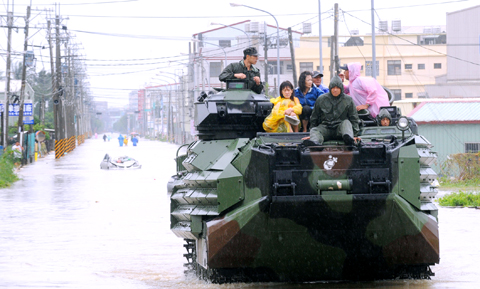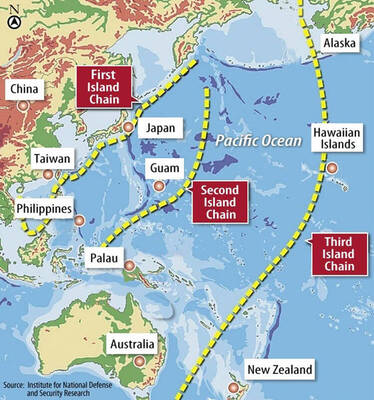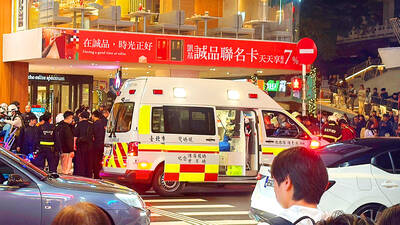The nation yesterday took stock of the damage caused by Typhoon Fanapi, which hit Taiwan on Sunday, causing billions of NT dollars in damage and leaving one person dead and about 100 injured.
Fanapi, the strongest storm to hit the nation this year, with gusts of up to 220kph, made landfall on the east coast on Sunday and dumped up to 1,000mm of rain in the south.
Kaohsiung City police authorities said the body of a 22-year-old woman was found in 20mm of water by a bystander on Jhonghua Second Road, near the Jiouru Second Road intersection at about 6:30am. A preliminary investigation found no other external causes of death.

PHOTO: CNA
Police authorities said the woman, surnamed Wu (吳), was in her fourth year at Cheng Shiu University. The student was apparently on her way home from her part-time job at a fast food restaurant when she drowned.
The Kaohsiung area bore the brunt of the high-levels of rainfall brought by Fanapi, which lasted until early yesterday morning. Local media reported that floodwaters near the intersection had reached waist level during peak rainfall on Sunday night.
The Central Emergency Operations Center (CEOC), a cross-departmental task force formed by officials from different government agencies, said 111 people were injured in the storm.
In its damage assessment, the CEOC said several areas in the southwest were still underwater yesterday, including Nanzih (楠梓) in Kaohsiung City, Rende Township (仁德) in Tainan County and Linbian Township (林邊) in Pingtung County.
TV footage showed residents of Nanzih picking up products floating by after convenience stores were destroyed by the flood. Rescue workers delivered food to Rende, where floods trapped residents.
The military said it had dispatched a total of 7,888 soldiers nationwide to deal with the typhoon.
By yesterday morning, soldiers had helped 7,508 people evacuate dangerous areas and housed 513 people in military units. The military set up five medical treatment centers in military bases in the south and planned to set up another four if necessary.
Soldiers helped residents clean away garbage and sludge, remove felled trees and clean up damaged sections of buildings.
Meanwhile, the National Airborne Corps said its 18 helicopters were ready to participate in rescue work.
Fanapi caused power outages in approximately 890,000 households nationwide. Water supply was also suspended in about 17,000 households. Both Taiwan Water Corp (自來水公司) and Taiwan Power Co (台電) were scheduled to resume water and electricity supply today.
Aside from damage to provincial highways, the Ministry of Transportation and Communications said the South Link (南迴鐵路), one of the main transportation systems connecting the nation’s southern and eastern regions, was severely damaged. The railway tracks on the Taimali River Bridge (太麻里溪橋) were washed out by surging water in the river, the ministry said.
The Taiwan Railway Administration said it expected that the South Link would be reopened within two weeks after the water recedes.
The Industrial Development Bureau said companies in the Renwu and Dashe industrial zones in Kaohsiung County suffered the brunt of the damage, with NT$3 billion (US$94 million) in estimated losses.
Operations at many facilities were suspended on Sunday after massive rainfall caused rivers to burst their banks, submerging roads and factories.
Affected companies — mostly petrochemical firms — included Formosa Plastics Corp (台塑), China Man-Made Fiber Corp (中纖), Pan Asia Chemical Corp (磐亞), Grand Pacific Petrochemical Corp (國喬石化) and TSRC Corp (台橡).
Bureau Deputy Director-General Lien Ching-chang (連錦漳) said up to 80 percent of the petrochemical firms in Dashe had resumed operations, while the remainder should resume business within the next two days.
Meanwhile, four water pumps were deployed at the hardest-hit Renwu industrial zone to help suck out the flood.
Renwu mostly houses pharmaceuticals and traditional enterprises. Facilities that were submerged in 100cm or more of water could take up to five days to resume operations, Lien said.
Formosa Plastics said in a filing to the Taiwan Stock Exchange that Typhoon Fanapi didn’t cause significant losses to the company.
The water receded from its Renwu plant early yesterday morning and the production lines restarted one after another from 8pm onwards, the statement said.
Damage to the farming sector was estimated at NT$260 million, the Council of Agriculture said.
The Hualien County Government said the storm destroyed banana, tea, corn, rice and pineapple crops on about 2,046 hectares of farmland, which resulted in losses of about NT$130 million.
A total of 203 schools reported damage by the typhoon as of yesterday, the Campus Security Center said.
Information from the center showed that 12 universities, 67 high schools and vocational high schools, 32 junior high schools and 92 elementary schools suffered NT$38 million in losses.
Schools in Tainan County suffered the most serious damages, totaling NT$7.8 million, followed by schools in Chiayi City, the center said.
Some schools and offices in Kaohsiung and neighboring areas were closed yesterday as the floods gradually subsided and soldiers pitched in to help residents clean up.
“This was the worst flooding we’ve experienced in my lifetime. It was even worse than the one caused last year by Typhoon Morakot,” one man told cable news network TVBS.
The Central Weather Bureau lifted both sea and land alerts for Fanapi at 2:30pm after it was reduced to a tropical storm and made landfall in Guangdong Province, China.
President Ma Ying-jeou (馬英九) visited disaster areas in Kaohsiung and Pingtung yesterday, promising to offer relief funds to victims of Fanapi in a speedy manner.
Ma said he hoped both the central and local governments would decide on the amount and standard compensation and then allocate the money as soon as possible.
Ma made the remarks in response to a request by victims and Kaohsiung Commissioner Yang Chiu-hsing (楊秋興). Yang said he hoped the compensation would be increased from NT$35,000 per family to NT$40,000.
Ma visited Ciaotou (橋頭), Kaohsiung County and Zuoying (左營) in Kaohsiung City before he headed to Jiadong (佳冬) and Dawu (大武) in Pingtung County, in the afternoon. Ma met residents in affected areas and thanked the military.
In Ciaotou Township, where water at one point was one story high, a man asked Ma to help resolve the long-standing problem of flooding.
“The government will celebrate the 100th anniversary of the Republic of China next year, but we have been suffering from flooding every year over the past century. Please do something,” one man said. “I haven’t been able to sleep since 3am. I don’t have to tell you how much I have lost, as you can see very clearly.”
Another man said the government claimed it has been dredging the nearby river, but it had been doing so for 10 years and the project was still not finished, causing more flooding whenever there was torrential rain.
Another man said he wanted to know why there was no water for them to shower and clean muddy homes.
One urged Ma to help them receive more compensation because they have suffered a great deal over the years.
Ma, who was criticized for being aloof and insensitive to victims when he visited southern Taiwan in the wake of Morakot in August last year, appeared more patient and compassionate yesterday.
He told victims he was there to understand their problems and promised to ask the Water Resources Agency to speed up the dredging project.
Despite Ma’s performance this time around, Yang Chiu-hsing said a drawn out Web cam conference on the government response to Fanapi between Ma and mayors and county commissioners across the country on Sunday morning was inefficient and a waste of time, adding that it became overly political and took valuable time away from response efforts.
“The entire [meeting] wasn’t needed,” Yang said, adding that the sit-down, which was supposed to have been led by Premier Wu Den-yih (吳敦義), turned into a Ma-hosted event.
Rather than promptly delivering typhoon preparation requests to the central government, Yang said local leaders had to sit through long and drawn out reports — some lasting up to 20 minutes — from other municipal leaders, before being given a chance to speak.
“A telephone call from each area would have done [the job],” he said.
Meanwhile, the Bureau of National Health Insurance (BNHI) reminded people who may have lost their NHI cards during the typhoon that they could still seek medical care and apply for a new NHI card free of charge.
Hung Ching-jung (洪清榮), deputy of the bureau’s Department of Business, said applicants could indicate on the application form that they were victims of Fanapi to waive the card processing fee when applying for a new one.
Hospitals and clinics were also required to provide medical care to needy Fanapi victims who have lost their NHI cards, Hung said.
In related news, the Department of Health advised people to boil water before drinking or washing utensils, as the amount of bacteria in tap water could be much higher after a typhoon.
ADDITIONAL REPORTING BY FLORA WANG, JASON TAN, RICH CHANG, SHELLEY HUANG , AFP AND CNA
Also See: Wang says flooding may hurt Chen Chu

The US government has signed defense cooperation agreements with Japan and the Philippines to boost the deterrence capabilities of countries in the first island chain, a report by the National Security Bureau (NSB) showed. The main countries on the first island chain include the two nations and Taiwan. The bureau is to present the report at a meeting of the legislature’s Foreign Affairs and National Defense Committee tomorrow. The US military has deployed Typhon missile systems to Japan’s Yamaguchi Prefecture and Zambales province in the Philippines during their joint military exercises. It has also installed NMESIS anti-ship systems in Japan’s Okinawa

TRAGEDY STRIKES TAIPEI: The suspect died after falling off a building after he threw smoke grenades into Taipei Main Station and went on a killing spree in Zhongshan A 27-year-old suspect allegedly threw smoke grenades in Taipei Main Station and then proceeded to Zhongshan MRT Station in a random killing spree that resulted in the death of the suspect and two other civilians, and seven injured, including one in critical condition, as of press time last night. The suspect, identified as a man surnamed Chang Wen (張文), allegedly began the attack at Taipei Main Station, the Taipei Fire Department said, adding that it received a report at 5:24pm that smoke grenades had been thrown in the station. One man in his 50s was rushed to hospital after a cardiac arrest

‘WIN-WIN’: The Philippines, and central and eastern European countries are important potential drone cooperation partners, Minister of Foreign Affairs Lin Chia-lung said Minister of Foreign Affairs Lin Chia-lung (林佳龍) in an interview published yesterday confirmed that there are joint ventures between Taiwan and Poland in the drone industry. Lin made the remark in an exclusive interview with the Chinese-language Liberty Times (the Taipei Times’ sister paper). The government-backed Taiwan Excellence Drone International Business Opportunities Alliance and the Polish Chamber of Unmanned Systems on Wednesday last week signed a memorandum of understanding in Poland to develop a “non-China” supply chain for drones and work together on key technologies. Asked if Taiwan prioritized Poland among central and eastern European countries in drone collaboration, Lin

ON ALERT: Taiwan’s partners would issue warnings if China attempted to use Interpol to target Taiwanese, and the global body has mechanisms to prevent it, an official said China has stationed two to four people specializing in Taiwan affairs at its embassies in several democratic countries to monitor and harass Taiwanese, actions that the host nations would not tolerate, National Security Bureau (NSB) Director-General Tsai Ming-yen (蔡明彥) said yesterday. Tsai made the comments at a meeting of the legislature’s Foreign Affairs and National Defense Committee, which asked him and Minister of National Defense Wellington Koo (顧立雄) to report on potential conflicts in the Taiwan Strait and military preparedness. Democratic Progressive Party (DPP) Legislator Michelle Lin (林楚茵) expressed concern that Beijing has posted personnel from China’s Taiwan Affairs Office to its